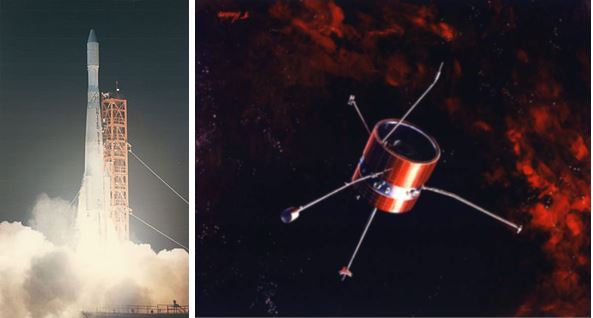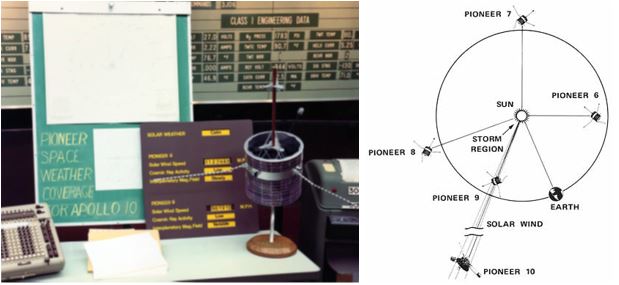In 1968, NASA’s primary focus was to land humans on the Moon and return them safely to Earth before the end of the decade. The Agency was also interested in studying interplanetary space and using that information to assist Apollo astronauts during their lunar voyages. NASA’s Ames Research Center in California’s Silicon Valley managed the lesser known but highly successful Pioneer program of solar orbiters. Between 1965 and 1968, four Pioneer space probes entered solar orbit to make comprehensive measurements of interplanetary magnetic fields and the flow and structure of the solar wind. The spacecraft also acted as the world’s first space-based solar weather network providing data on solar storms that can impact communications and power systems on Earth, and that could potentially affect Apollo astronauts traveling to the Moon and back.
The fourth in the series, Pioneer 9, launched November 8, 1968, on a Delta E rocket from Cape Kennedy, Florida, and entered a solar orbit with a mean radius just slightly inside Earth’s, making a revolution around the Sun every 298 days. Equipped with eight instruments, the solar powered probe recorded and transmitted data on magnetic fields, plasma, cosmic rays and cosmic dust in interplanetary space. Scientists correlated the findings from these instruments with information gathered by the other Pioneers, in similar solar orbits but spaced at varying intervals from each other, just inside or outside of Earth’s orbit. During the Apollo lunar missions, the fleet of Pioneers provided hourly updates on the Sun’s activity. Shared with flight controllers in Houston, their data provided early warnings of intense, otherwise unexpected blasts of solar protons that could have endangered the lives of astronauts.
Planned for six-months of operations, all four Pioneers far exceeded their design lives. Taking advantage of this longevity, scientists used the spacecraft to conduct joint observations of a large solar flare in August 1972 with another spacecraft, Pioneer 10, then more than twice the Earth’s distance from the Sun and on its way to Jupiter. Contact with Pioneer 9, launched 50 years ago today, was lost in 1983. The hardy little space probe helped characterize the interplanetary space environment and contributed an extra margin of safety for Apollo astronauts during their lunar missions.
For more on Pioneer 9, see https://www.nasa.gov/centers/ames/missions/archive/pioneer.html





























